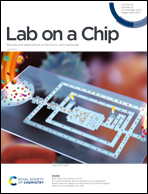Continuous and spontaneous nanoparticle separation by diffusiophoresis†
Abstract
The separation of nanoparticles has drawn critical attention in various microfluidic applications including chemical analysis, diagnostics and environmental monitoring. Thus, a number of nanoparticle separation methods have been extensively proposed. However, most of the conventional methods require complicated structured devices, expensive manufacturing processes, and external power sources. While a spontaneous diffusiophoretic separation device based on an ion exchange mechanism could overcome such drawbacks, the recovery of separated particles and the inevitable development of an acidic environment due to the release of H+ from the cation exchange membrane limit its practical applicability. Therefore, in this work, we present a simple but robust nanoparticle separation method based on spontaneously induced diffusiophoresis, which is operated in a continuous manner to overcome the limitations of conventional methods. First, we confirmed that the particle exclusion distance followed the previously developed scaling law of diffusiophoresis. Consequently, we demonstrated the separation of nanoparticles of 40 nm, 200 nm and 2 μm diameter by utilizing the fact that the exclusion distances of various particles were proportional to their diffusiophoretic mobility. Furthermore, the use of Tris buffer increased the diffusiophoretic migration of nanoparticles due to the enhanced concentration gradient, and enabled the produced solution to be compatible with pH-sensitive bio-samples. Therefore, we expect this continuous and spontaneous diffusiophoretic separation platform to be useful in practical applications for analyzing various nano-meter scale bio-particles.



 Please wait while we load your content...
Please wait while we load your content...